The payments landscape is rapidly evolving, with a global payments revolution seeing shoppers increasingly adopting alternative payment methods outside of the traditional ways to pay. While mainstream payment methods like cash and major debit/credit cards (Visa, Mastercard, American Express) aren't going anywhere in the near future, alternative payment methods are soaring in popularity.
Read more about alternative and real-time payments and why they're key to your future growth.

Read more about alternative and real-time payments and why they're key to your future growth.
Alternative payment methods refer to forms of payments aside from cash, this may be credit cards, cryptocurrencies, and so forth. This shift has been largely due to the arrival of financial technology companies and tech giants in the payments ecosystem. By providing consumers with more convenient payment options, they've shaken up the industry and placed consumers firmly in the driver's seat.
Alternative payment methods can give merchants a significant edge on competitors, so it's important to offer a broad range of payment options at the checkout point.
Let's look at exactly what alternative payment methods are, and why they're crucial to the success of any online business.
Alternative payment methods explained
It's convenient to attribute the rise of alternative payments to COVID-19, but the truth is, technology has been steering the payments industry and payment service providers towards faster, more convenient ways to exchange money for decades.
COVID has certainly accelerated changes to consumer shopping and payment habits by removing the option to buy from physical stores, and necessitating a huge shift to online purchases. However, FinTechs have been riding the wave in tandem with consumer demands, realizing that shoppers no longer wish to be restricted by traditional shopping methods and conventional ways to pay.
The key factor in the rise of alternative payment methods is the desire for a convenient, hassle-free, omnichannel payment experience. The consumer-driven surge in omnichannel digital banking and retailing, has provided consumers with more choices in the way they pay than ever before.
Popular alternative payment methods
Checkout technology has become much more sophisticated, making the implementation of alternative payment methods significantly safer and more convenient for merchants and consumers. Each alternative payment method has its reasons for popularity with shoppers, but convenience is the underlying consideration for many consumers.
Online banking
Online banking refers to a preferred payment method made from a bank account that doesn't require the input of credit or debit card information.
Electronic wallets (e-wallets)
Electronic, or digital wallets are online payment tools, usually in the form of an app. Customers load their e-wallets with funds via bank transfer, card or cash and use them to make payments online, offline, as well as person-to-person and cross-border in some cases.
The e-wallet securely stores virtual versions of debit and credit cards, so shoppers don’t need to enter debit or credit card details or carry a physical card at all to make payments. E-wallets also have the ability to store and save digital tickets and e-vouchers, to keep needed documents on hand. Examples include PayPal and Alipay.
Mobile wallets
Mobile wallets are a type of digital wallet used to make contactless mobile payments in place of a credit card or cash. Apple Pay, Google Pay and Samsung Pay are examples of mobile wallets, accessed through apps downloaded to a smartphone or wearable device. In addition to making payments with a single tap, they can also be loaded up with concert tickets, travel passes, and loyalty cards, or anything that can be placed in a physical wallet.
Digital wallets are designed to add another level of safety and security. Physical cards and cash are easy to lose or steal. Electronic details are password-protected, often with an added biometric layer of security and other features including:
- Tokenization to process payments without sharing card numbers – the numbers are encrypted and replaced with a token.
- Remote data erasure – if your phone is stolen, Samsung, Apple, and Google all allow you to wipe your mobile wallet data remotely.
Buy-now-pay-later (BNPL)
BNPL is a popular alternative payment method because it allows customers to either pay the whole amount later or spread an item’s cost over several instalments, usually without having to pay interest or transaction fees. Purchases are mostly funded via a bank account, debit or credit card. Klarna, Affirm and Afterpay are a few examples of this alternative payment method.
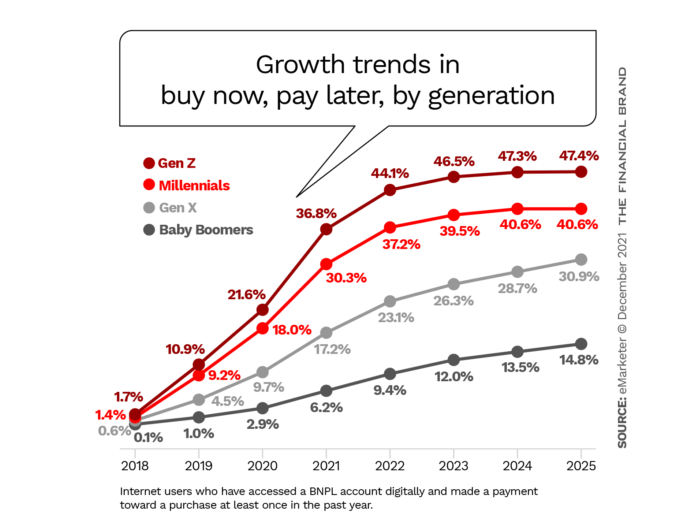
Direct Debit
Direct debit is one of the key alternative payment methods favored by many subscription-based businesses to make payments directly from a customer's bank account to a business's bank account. Working with a payment service like GoCardless, Direct Debit is a great way to accept recurring payments while reducing your susceptibility to involuntary customer churn .
Read our guide to involuntary churn and how to prevent it here
Bank transfers
Also referred to as wire transfers, bank transfers directly move money from a customer bank account to business's bank account. While this alternative payment method is gaining popularity, it does come with some risks.
Sometimes, payments can be misdirected, and if this is a manual error on the customer's part, the chances of recovering any losses are slim. Another risk is that bank transfer is a common way for scammers and fraudsters to steal money by trying to sell tangible products, and not providing a money back guarantee.
Prepaid cards
Some businesses, such as retailers and utility suppliers offer cards on which to store funds to make payments, rather than using bank transfers or direct debits. These cards are essentially prepaid accounts which can have funds deposited or transferred online and used to pay for goods and services.
Cryptocurrencies
Another, more recent addition to the alternative payment method stable are cryptocurrencies like the popular Bitcoin, but there are vast numbers of cryptocurrencies (over 2,000 as of January 2020) to explore. While many cryptocurrencies are volatile and may be difficult to actually use to make transactions, it's predicted by financial experts that they will be an important part of the payments space in the future.
Real time payments
One of the other alternative payment methods changing the global financial landscape is real time payments sometimes called instant or Immediate Payments (IP). Real time payments provide the capability to transfer funds locally or internationally between individuals, businesses and governments, making those funds available to the payee instantly, and with instant confirmation.
Real-time payments offer a faster, more consistent means of payment compared to some legacy methods, which could take days to reach a recipient. This newer, more seamless way to make financial transactions will affect consumers, businesses and world governments, both socially and economically.
Find out more about how real time payments are changing the world
Global alternative payment methods
While alternative payment methods continue to gain worldwide acceptance by banks, financial institutions, consumers and merchants, there is no single, global way to pay.
Every country has unique payment methods, banking rails, regulations, requirements and licensing requirements. Payment habits tend to change and develop over time and are often formed by various cultural, political or economic and technological factors. Let's take a quick look at some of the alternative payment methods in some key world economies.
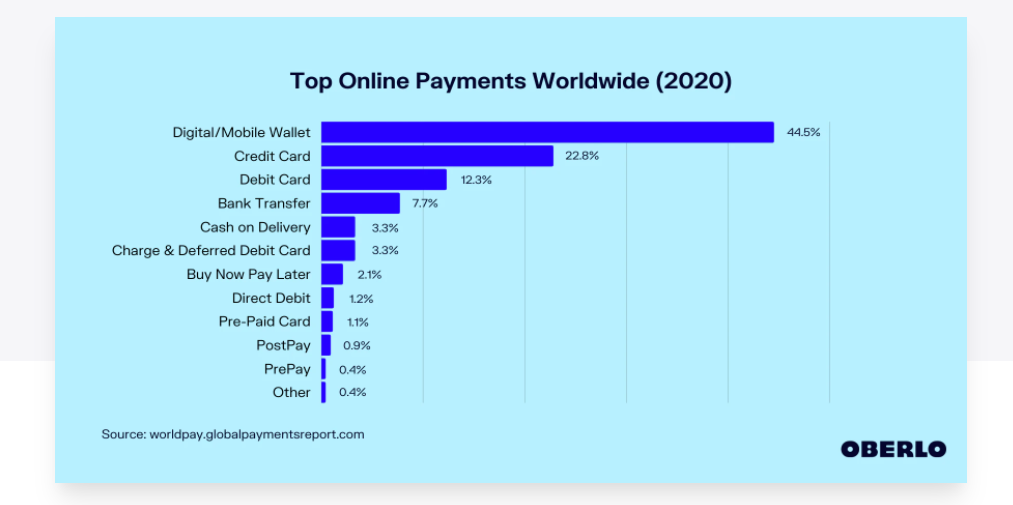
Image source: Oberlo
North America
Paying by card continues to be the dominant online payment method in North America, although research conducted on behalf of Paysafe by Sapio Research in March and April 2021 explored changing consumer payment behaviors in selected countries. More than a third (38%) of consumers say they are now more informed of the wide range of different mobile payment options available to them than they were prior to the pandemic, and almost a third (31%) are now more likely to use an alternative payment method.
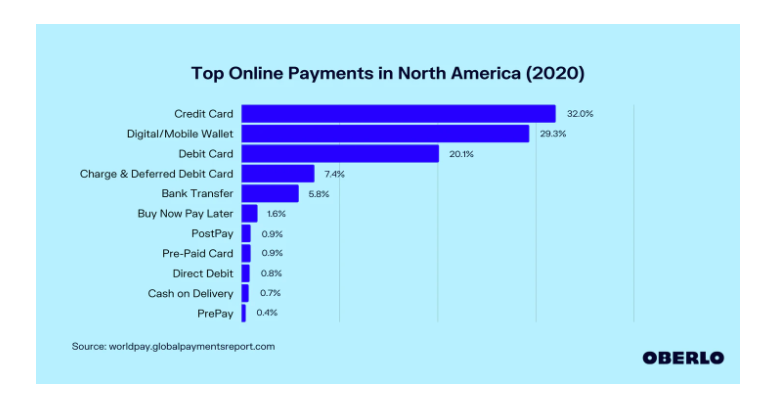
South America
According to the Latin American Online Payment Methods Report, 50% of consumers prefer using cards when shopping online. This accounts for the international card schemes, as well as local schemes like Elo and Hipercard. Cash on delivery is also popular given the region’s large unbanked population.
Increasingly the use of e-cash solutions, an offline way to make online purchases, is becoming more widespread and is particularly suited to a region with a high unbanked population. Popular examples of e-cash in South America include Boleto Bancário in Brazil and OXXO in Mexico.
Europe
The landscape is similar in Europe to that in the US. Cards are by far the most popular method of online payment. But alternative payment methods are rising in popularity, with 16% of consumers preferring to use bank transfer methods, especially in Austria. Other alternative payment methods, like Apple Pay, were preferred by 6% of online shoppers.
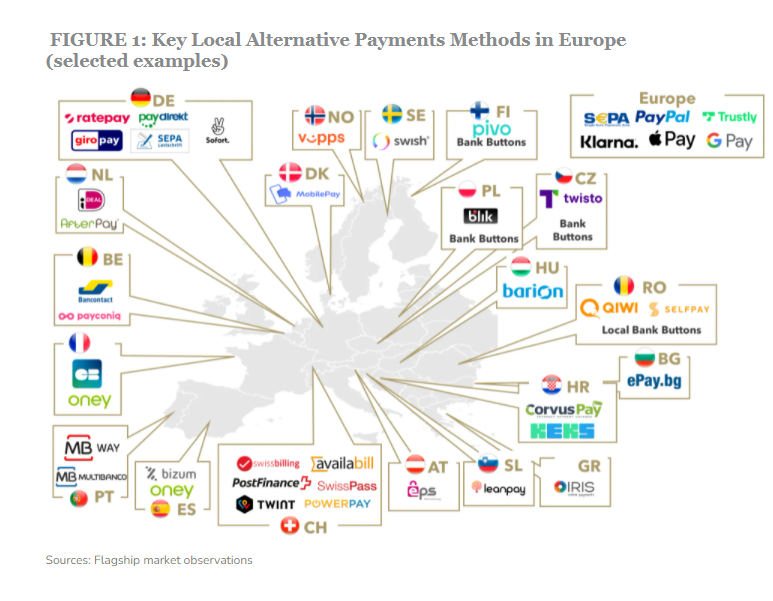
Image source: Flagship
Middle East
In the Middle East, cash has reigned supreme until recently. In several markets, such as Bahrain, Qatar, and Saudi Arabia, cards are the favored online payment method. This is driven by deeper penetration from the international brands, as well as the development of government-backed payment networks. Examples include KNet in Kuwait, Oman Net in Oman, QPay in Qatar and mada in Saudi Arabia.
Asia Pacific
China has a robust domestic card scheme, with UnionPay constituting 45% of global card spending.
But figures show that $120 trillion in transactions were made using mobile wallets across China in 2020, with Alipay and WeChat Pay commanding a dominating 90% share between them. There is a large variety of popular alternative payment methods used by consumers across the rest of the region also. Some examples include GrabPay in Singapore, OVO Wallet in Indonesia and True Money in Thailand.
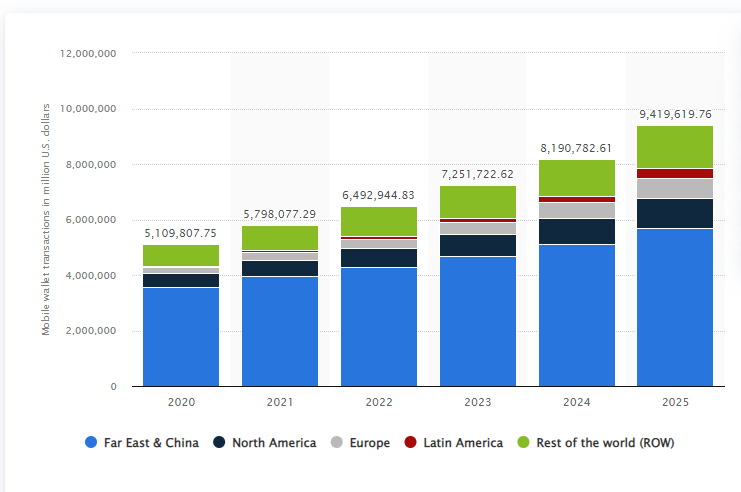
Image source: Statista
Why alternative payment methods are vital to any business
Businesses can offer their customers the perfect product for their market, but if they don't offer the alternative payment methods those customers prefer, they risk losing potential sales. This is particularly important for differing markets like China.
Alternative payment methods are characterized by security, speed and ease of use, so accepting alternative payments is fundamental not only for e-commerce, but for all commercial activities. Here's why:
Frictionless payments avoid abandoned shopping carts
Alternative payment methods help to remove barriers to sales. U.K. studies reveal that 60% of customers will abandon shopping baskets if they encounter friction at the checkout. BNPL has boomed in popularity, giving potential customers another option if they're experiencing a temporary cash flow issue.
Saving credit card processing fees
Alternative payment methods represent potential savings on credit card transaction fees, which have doubled for businesses in the last decade. While accepting credit cards are still necessary for merchants, they still amount to a potential drain on profit margins. As more customers flock to using alternative payment methods, the amount margin sacrificed to credit card fees will decline.
A better Customer Experience
A business's main objective is to build and grow their brand, and this begins with creating a positive association for customers. Alternative payment methods give customers a variety of options that are quick, convenient and safe. Greater encryption, biometric authentication and tokenization means that alternative payment methods are even more secure than chip and PIN transactions.
Businesses also need to make sure that your payments technology stack is suited for their particular business, allowing for the addition of new payment methods at speed and without creating additional complexity. Not all payment providers can deliver on this, so it's important to work with a payment provider that supplies the coverage needed, as well as capabilities to adapt and evolve as the business develops.
Monitoring and managing the adoption of alternative payment methods
With today’s uncertain business environment, it is difficult to predict what payment technologies will suddenly gain popularity. Real-time transaction insights give retailers visibility into the growth of individual technologies so they can see how the servers are responding, how users are experiencing that service, and can adjust platforms as necessary.
A merchant’s ability to adjust to changing payment types and the increased importance of the e-commerce channel depends on having instant, real-time visibility into what transactions are occurring on what channel and how well they’re performing. Having the appropriate real-time actionable insights can help merchants identify trends and patterns to inform strategic decisions.
How IR Transact can help
IR Transact brings real-time visibility to your entire payments environment, unlocking unparalleled insights into transactions and trends, streamlining the payments experience, from end-to-end. The financial services industry deals with massive data volumes, so it's critical to detect complex patterns in real-time, correlate this information and analyze it quickly.
Transaction analytics and insights drive sales and provide more streamlined services to customers. For banks, central infrastructures and other key players in the real-time space, transaction monitoring identifies glitches in payment systems and mitigates risk.
For financial institutions, transaction monitoring can analyze historical information and spot abnormalities and fraud attempts.
Read more about the key business drivers for real-time payments transactions here
Read more about alternative and real-time payments and why they're key to your future growth.

Read more about alternative and real-time payments and why they're key to your future growth.




